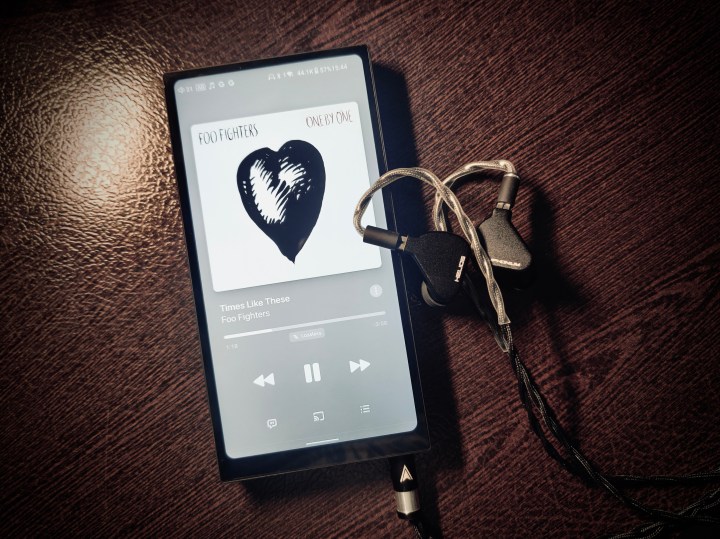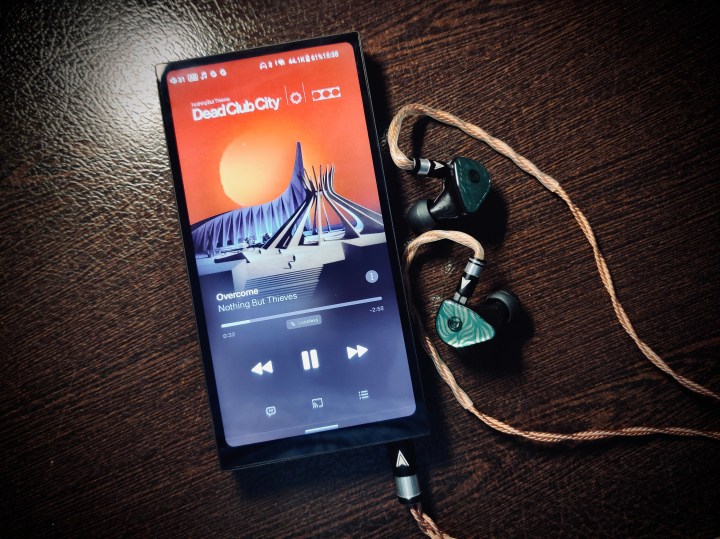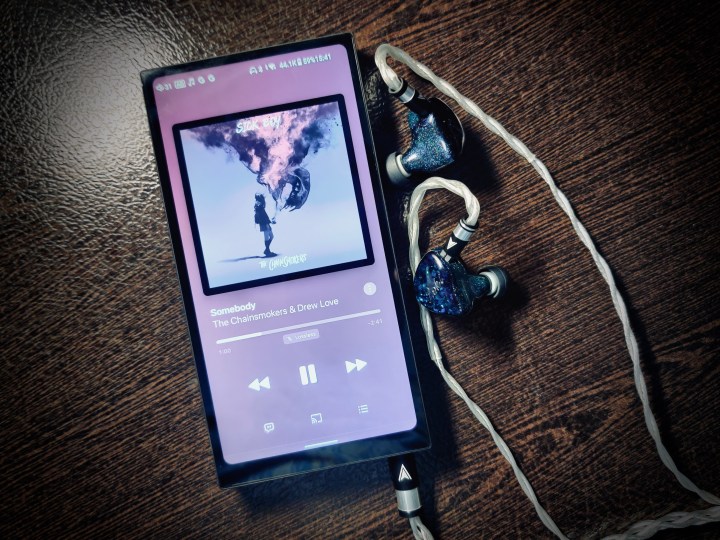Cable Testing Process and some advice for people getting into cables.
I tried removing most variables to keep the tests simple, easy and clean. Here’s my process –
- 5 flat impedance IEMs as reference (besides IEMs used for Pair-Up impressions) – 64 Audio U12t, Softears RS10, Symphonium Helios, Custom Art FIBAE 7U, FIBAE 5 and H3 Pro. They all have different sound signatures but with the flat impedance tech, it helps keep them impervious to impedance differences between different sources and cables.
- Two sources for consistency and cross referencing – HiBy R6 Pro II and iBasso DX240.
- Volume levels matched by ear and IE711 coupler precisely in order to remove the effects of volume mismatch (read how volume boosts change perception of sound signature).
- Same ear tips – Azla Sedna Standards
- Tested with fresh ears early in the day.
- Tested first compared to their respective stock cables.
In my opinion, cables do not have a sound themselves but rather act as a medium between the source and transducer where their resistance, capacitance, geometry, gauge and conductivity can play a role in influencing the sound, which in the larger picture is generally minor than substantial. The perception of the amount and scale of differences between cables depends on how down the rabbit hole you are and how obsessive you are about the slightest differences when wanting to perfect your setups to the best version they can be as per your preferences.
In general, what you listen to is majorly the sound signature of the IEM/headphone but it is the synergy between all three; source, cable and transducer – which when perfected, makes a good combo – a great one. The obsession to perfect this combo completely lies in the ears, patience and budget of the beholder and a lot of times, you don’t even need to spend the biggest bucks to make a great combo! But if you do not like the sound signature of your IEM/headphone to begin with, no cable or DAP can help make that better for you. You’d be better off buying a new IEM/headphone that is more in line with your preferences than you spending a lot of money on sources and cables to try and fix something specific, which in most cases won’t ever happen.
With that said, I tested these cables with multiple sources and IEMs from my arsenal but the sound analysis was primarily written with HiBy R6 Pro II and ibasso DX240 as the sources and 64 Audio U12t, Softears RS10, Symphonium Helios and Custom Art FIBAE 7U, FIBAE 5 & H3 Pro as the reference IEMs. These IEMs have different sound signatures but most importantly a flat impedance design that makes them impervious to the influence of impedance differences between sources and cables.
Sound Analysis.
Voyager.
Voyager has the perfect thickness for on-the-go use but it’s the cloth cover that makes it pick up movements on the body. Otherwise, the thickness and ergonomics of Voyager are ideal for on the go use as well as live performance. As for sound, it is a very clean sounding cable that I hear focusing on clarity with particular focus in the upper-midrange that helps highlight instrument definition and resolution. It enables a very clean soundstage with good depth. It’s not a bright cable per se but one that goes for clean conduction and clarity over warmth.
Ideal pairing – I’d recommend pairing Voyager with IEMs you feel are lacking clarity or lacking definition in the midrange.
Voyager Pair-Up Impressions with IEMs.
Symphonium Meteor – Meteor can come off a bit too bassy with some cables and for my own preference and hence I prefer pairing it with cables that are cleaner and focus on definition. This is exactly what the Voyager helps with in this case and makes Meteor sound cleaner and more defined in the upper-midrange and treble than it does with its stock cable. I perceive slightly better instrument definition and a deeper soundstage with it.
Custom Art FIBAE5 – With the boosts in F5’s both ends of the spectrum and a dip in the upper-midrange, I sometimes wish F5 had slightly stronger instrument forwardness and definition. This is where I feel Voyager pairs really well as it adds in more definition to upper-midrange, improving instrument tonality and presence. I also hear it tightening F5’s big bass shelf and improving the speed, attack and precision.
64 Audio U12t – This is a very well tuned IEM but the dip in the 2-5kHz smoothens out the instrument definition and attack for me and I like Voyager as the ideal pairing for such an application. I hear Voyager cleaning up the midrange and adding on to the upper-midrange definition, bringing out better instrument definition, clarity and separation.
Symphonium Helios – Just like the U12t, Helios has excellent tuning but dips the upper-midrange around the 3kHz area which slightly dims the instruments definition compared to reference accuracy and me being a reference head wishes it wasn’t there. Voyager not only helps in this regard but also with even better layering and separation than the stock cable. I perceive slightly deeper soundstage and very slightly better bass dynamics with Voyager too.

Pulse.
Pulse has excellent ergonomics and minimal microphonics. With a very light y-split and very well crafted ear guides, it hardly has any downward pull. In sound, this is a cable that evens out the sound and pushes for a richer tonality with a slightly fuller effect on the IEM’s signature. It’s not warm cable as such but one that evens out the erratic treble peaks a bit and highlights the sub-bass rumble. It’s also a cable that pushes resolution without brightness and because of its richer tone, I hear better layering and a blacker background that is more easily perceivable than cheaper stock cables.
Ideal pairing – This is quite a versatile cable but I’d recommend pairing it with IEMs that need evening of sound or when you want to add a slightly fuller, richer tonality to a leaner IEM or push the sub-bass rumble a bit more.
Pulse Pair-Up Impressions with IEMs.
Kinera Loki Emerald (LE) – LE is a very well tuned IEM and comes stock with 2 cables – an Effect Audio Ares S and a custom cable made specifically for Loki Emerald but I find its pairing with Pulse better than both the stock cables. I perceive sub-bass getting rumblier, midrange getting a bit more body and it evening out the mid-treble sizzle. I also perceive a bit more resolution in the background and the soundstage becoming more holographic compared to stock cables.
Custom Art FIBAE 5 – F5 has significant boosts at both ends with a 14dB bass shelf and significant boosting in mid-treble. Pulse pairs quite well with F5 as I hear it evening out the sizzle, making the treble sound more natural, it enabling more weight in the bass region and making the midrange sound slightly richer. All this results in a more even and natural sound presentation.
Custom Art Hybrid 3 Pro – H3 Pro has a neutral-bright leaning signature with the stock Brown Filters. The stock cable is quite ergonomic but isn’t the best for sound performance. With Pulse, I hear H3 Pro having a more even sound signature where it evens out the treble peaks and makes the bass and midrange sound richer. I perceive a more layered, more open soundstage with better left to right separation.
Kinera Nanna 2.0 – Nanna 2.0 has a slightly leaner, neutral bright signature which makes for a vivid and energetic presentation of music. Pulse is a very good pairing with Nanna 2.0 as it adds some definition in bass, slightly fuller body and making for a more even balance with treble. I hear better background depth and slightly better separation overall.

Reference Silver.
Even though Pulse has excellent ergonomics, Reference Silver is even better and is even lighter than Pulse. This is one of the cables that has good thickness and yet disappears like slimmer cables when using on the go or performing live.
In terms of sound performance, this cable is one of the cleanest and most transparent cables I’ve tried and one that enables good resolution, separation and clarity without any brightness. Astral calls it an all-rounder, reference cable and I have to say that I quite agree with that statement. I hear it enabling a very good clean sound performance and. extracting very good details without adding any colour to the IEM’s sound signature. This is one of the first cables I now generally pick to test an IEM’s true tonal and technical performance. I hear it enabling a good black background with certain IEMs and very good instrument definition in the stage leading to a holographic performance with capable IEMs.
Ideal pairing – This is a cable I’d recommend when you want to extract the cleanest tonal and technical performance without addition of any extra colour. Best to pair with IEMs you like the tonality of and when you want to extract the cleanest sound and technicalities out of it.
Reference Silver Pair-Up Impressions with IEMs.
Kinera Loki Emerald (LE) – This is a very good pairing if you want to keep LE’s vivid and exciting signature intact but push for a slightly more open and deeper soundstage with better depth layering and separation over EA Ares S that promotes a slight warming effect down low. I perceive slightly better bass attack, precision and separation and slightly better imaging overall.
64 Audio U12t – For all people who feel U12t’s bass can sometimes come off a bit warm or soft with some cables, especially the cheap stock cables, Reference Silver is a very good pairing to present a very clean version of U12t’s signature where I perceive it improving on the stage openness and depth as well as background resolution and instrument imaging.
Softears RS10 CIEM – The CIEM version is a very slightly warmer and fuller than the RS10 UIEM. It has a reference-ish signature and even though it has flat impedance technology, some cables tend to make it sound warmer due to their own nature, which takes away the number 1 thing I like about RS10 and that is its very clean and clear signature. For this I cable rolled with several cables and Reference Silver was the one that paired best with RS10. It presented the best left to right separation, best stage depth, most open feeling soundstage and best imaging.
Lime Ears Anima – Due to Anima’s coloured signature and extra fullness in the 500-2kHz region, I prefer cables that have clean, colourless conduction over cables that tend to add warmth or fatness to that region. For primarily this reason I prefer Anima’s pairing with Reference Silver. I also hear better left to right separation, better depth layering, a slightly more open and airy soundstage and better instrument definition with Reference Silver over the stock Khanyayo + Viking Weave stock cable.
Symphonium Helios – I quite like Helios’ stock signature but the dip in 2.5-7.5kHz sometimes makes it sound a little softer and I wish it had a bit more clarity and definition with the stock cable pairing. I perceive Reference Silver improving those areas for me, especially a cleaner stage, slightly more resolution, cleaner separation between instruments, slightly better instrument presence in the stage and slightly wider and deeper stage boundaries.
Custom Art FIBAE 5 – If you’re a fan of of F5’s default signature, Reference Silver is the cleanest pairing I’ve found that keeps the vivid and energetic presentation intact but greatly improves resolution, clarity, the already good left to right separation and imaging. I perceive it improving stage depth and making the instruments slightly better defined in the stage too.
Custom Art FIBAE 7U – Again, like the RS10, I was on a lookout for a cable pairing that presented the cleanest version of F7U’s original stock signature and after quite a bit of A/B testing, it came out to be Reference Silver here too. It keeps the original signature intact while improving on the resolution, openness and depth of stage, imaging, depth layering and instrument separation.

Eclipse.
Just like the Reference Silver, Eclipse is equally impressive in terms of ergonomics and is as light weight for on the go or live use. In terms of sound, this is a complementing cable to Reference Silver’s clarity oriented performance. It is a cable that promotes a very smooth tonal performance with some richness in the midrange, slight evening of the treble peaks and extra focus on the sub-bass rumble. This is an excellent example to show that you can’t stereotype materials to display a certain effect – a trend which generalises copper cables as warm and silver cables as bright. I primarily hear Eclipse sounding close to Pulse but improving on separation, stage depth, instrument realism and very slightly layering.
Ideal pairing – I’d recommend Eclipse for IEMs where you want a nice even sounding cable with a slight warming effect but one that promotes cleaner performance and technical aspects like better layering and separation.
Eclipse Pair-Up Impressions with IEMs.
Kinera Loki Emerald (LE) – This is a good pairing. It slightly evens out the mid-treble peaks but improves on the technical performance over the stock EA Ares S. I mainly perceive a more open and deep soundstage, better instrument definition, better left to right separation and a slightly blacked background.
Craft Ears Six CIEM – I initially settled on Pulse with CE6 to even out its airy upper-treble boosts and add some body to it’s otherwise vivid signature but then I heard Eclipse doing some things for the better. It has a slightly less warming effect on CE6 but improves the technical performance over Pulse, particularly left to right separation, imaging and stage depth – which is why I now having Eclipse paired with CE6.
Custom Art FIBAE 5 – Eclipse paired with F5 has a slightly different effect when its paired with Pulse. I hear Eclipse promoting sub-bass but instead making the lower-midrange when compared to Pulse. It does even out its sizzly mid-treble peaks but sounds very slightly more vivid than F5 + Pulse. It also has slightly better left to right separation and a deeper stage depth when compared to F5’s pairing with Pulse.
Kinera Nanna 2.0 – If you like Nanna 2.0’s stock signature but want a cable that focuses on promoting sub-bass rumble without having too much of a warming effect on the midrange or treble, Eclipse is a good pairing. It also improves the separation, depth layering and imaging over the stock cable.

Conclusion.
Astral Acoustics have quite a nice lineup with different types of cables; all of them with good design language and high quality components. For me, my favourite out of the bunch was Reference Silver. It’s the cleanest sounding cable which focuses on cleanest sound conduction and high technical performance. Pulse and Eclipse make for good pairing when you need to even out erratic treble peaks or push slightly more bass rumble, punch or body. Voyager is a very nice clean sounding cable that promotes definition and clarity but its cloth sheath makes it prone to picking up the slightest of movements on the body, like every cloth covered cable does, which is a little off-putting at times. But the best thing I like about their cables is that all of them are very ergonomic and supple, which makes them very easy to use for live performance as well as on the go use. This is not as common in the premium cable segment as one would imagine even though expecting cables to be ergonomic and supple as a basic function should be a given. Some premium cables tend to have a bit too much downward pull because of heavy y-splits or get a bit too bulky and uncomfortable for in home use, let alone on the go use. The main con and my main suggestion for the brand is to maybe re-think the current pricing and try and make them more affordable and accessible to a wider array of enthusiasts, not just ones with big pockets. You do get a quicker build time of 5 days and 3 years of warranty with the more expensive Reference Silver and Eclipse but still, the current pricing is still on the higher side. With that said, if you’re a cable enthusiast with a good budget who is looking for that last bit of refinement to perfect his/her combo while wanting the best comfort and ergonomics to go with it, I recommend having a look at Astral Acoustic’s lineup.
Gear used for testing and review.
- IEMs – 64 Audio U12t, Softears RS10, Symphonium Helios, Custom Art FIBAE 7U, FIBAE 5 & H3 Pro, Kinera Loki Emerald, Lime Ears Anima, Lime Ears Pneuma, etc.
- DAPs – HiBy R6 Pro II and iBasso DX240
- Phone – OnePlus 7 Pro + Tanchjim Space Dongle | iBasso DC04
Artists I like and listen to.
- Rock – Foo Fighters, Linkin Park, Switchfoot, Imagine Dragons, Daughtry, Green Day, MuteMath, X Ambassadors, Dave Matthews Band, Vertical Horizon, Our Lady Peace, Lifehouse, Fall Out Boy, Breaking Benjamin, Muse, ACDC, Audioslave, Rage Against the Machine, Biffy Clyro, I Am Giant, Normandie, Paramore, Slash & Guns N Roses, 3 Doors Down.
- Pop Rock – John Mayer, Coldplay, Paul McCartney, James Bay, Hunter Hayes, Niall Horan, Keith Urban, The Bros Landreth, Bryan Adams.
- Progressive Rock/Metal – Porcupine Tree/Steven Wilson, Karnivool, Tool, Dead Letter Circus, Periphery, Lamb of God.
- Pop/Soft Rock – Ed Sheeran, Adele, Taylor Swift, OneRepublic, The Script, Gavin James, Magic Man, Maroon 5, Bruno Mars, Charlie Puth, Dua Lipa, The Weeknd, Oasis, Panic! At the Disco, TwentyOne Pilots.
- EDM – Chainsmokers, Zedd.

